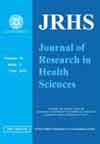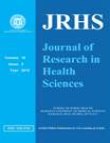فهرست مطالب

Journal of Research in Health Sciences
Volume:18 Issue: 4, Fall 2018
- تاریخ انتشار: 1397/09/26
- تعداد عناوین: 8
-
-
Page 1BackgroundObesity is a major public health problem because of its associated diabetes mellitus and cardiovascular disease. We aimed to explore the relationship between dietary macronutrients and adiposity in a cohort study, representative of the city of Mashhad in northeastern Iran. Study design: A cross-sectional study.MethodsThe population sample (9847) derived from Mashhad stroke and heart atherosclerotic disorders (MASHAD: 2010-2020) and was obtained using a stratified-cluster method. The subjects were separated into 4 groups by body mass index status: normal weight, underweight, overweight and obese individuals. Individuals with mean age of 48.33 ±8.26 yr were recruited and anthropometric and biochemical factors were measured in all the subjects. Individual dietary intakes were assessed using 24-h dietary recall Dietplan6. Univariate and multivariate analyses were conducted before and after adjustment for age, gender and energy intake.ResultsObese individuals were significantly less physically active. They had higher levels of serum fasted lipid profile, hs-CRP, uric acid, and glucose, and blood pressures compared to normal weight individuals (P=0.001). There was a significant difference in the dietary intakes of the groups categorized by obese before adjustment for energy intake in the obese compared to the normal weight group. These differences remained statistically significant for Trans fatty acid (P=0.033), lactose (P=0.009), fructose (P=0.025), glucose (P=0.017), sucrose (P=0.021) and maltose (P=0.015) after adjustment for energy intake.ConclusionOur findings demonstrate a significant association between dietary Trans fatty acid and total sugar intake with adiposity in a representative population sample from northeastern Iran.Keywords: Dietary intake, Body mass index, Nutrient, Obesity
-
Page 2BackgroundDetermining the epidemic threshold parameter helps health providers calculate the coverage while guiding them in planning the process of vaccination strategy. Since the trend and mechanism of influenza is very similar in different countries, we planned a study with the mentioned goal by using data of US from 2017 to 2018. Study design: A secondary study.MethodsR0 and corresponding vaccination coverage are estimated using the national and state-level data of the US from the 40th in 2017 to the 5th week in 2018. Four methods maximum likelihood (ML), exponential growth (EG), time-dependent reproduction numbers (TD), and sequential Bayesian (SB) are used to calculate minimum vaccination coverage. The gamma distribution is considered as the distribution and the generation of time.ResultsThe peak of epidemy in most states has occurred in the 15th week after the beginning of the epidemics. The generation time obey the Gamma distribution with mean and standard deviation of 3.6 and 1.6, respectively, was utilized for the generation time. The R0 (vaccination coverage) equaled 1.94 (48.4%), 1.80 (44.4%), 3.06 (67.3%), and 2.11 (52.6%) for EG, ML, SB, and TD methods at the national level, respectively.ConclusionThe R0 estimations were in the range of 1.8-3.06, indicating that an epidemic has occurred in the US (R0>1). Thus, it is required to vaccinate at least 44.4% to 67.3% to prevent the next epidemics of influenza. The findings of this study assist futures studies to apply disease control by vaccination strategies in order to prevent a national disaster.Keywords: Basic reproduction number, Epidemic threshold parameters, Vaccination coverage, Influenza
-
Page 3BackgroundRisk taking behaviors have several negative consequences. This study aimed to identify the subgroups of students based on risk-taking behaviors and to assess the role of demographic characteristics, depression, anxiety, socioeconomic status (SES), physical inactivity and screen time on membership of specific subgroup. Study design: Cross-sectional study.MethodsThis nationwide survey was conducted in 2011-2012 among 14880 students, aged 6-18 yr, selected by multistage, cluster-sampling method from 30 provinces of Iran. The students completed two sets of anonymous and validated questionnaires, obtained from the World Health Organization-Global School Health Survey questionnaires. Latent class analysis was performed to achieve the study objectives.ResultsOverall, 13486 children and adolescents participated were enrolled (response rate 90.6%). They consisted of 50.8% boys, with a mean age of 12.47 ±3.36 year. The prevalence of physical fight, bullying, victimization, active smoking, passive hookah and passive cigarette smoking was 39.7%, 17.4%, 27.2%, 5.9%, 21.1 and 33.8%, respectively. Five latent classes were identified: (a) low risk (46.7%), (b) passive smoker (25.2%), (c violence and aggression taker with passive smoking (13.5%), (d) violence and aggression taker without passive smoking (10.8%) and (e) high risk (3.8%). Higher age (OR=1.41), being male (OR=5.21), depression (OR=4.58), anxiety (OR=3.38) and screen time (OR=3.11) were associated with high-risk class.ConclusionThe prevalence of some risk-taking behaviors among Iranian students is high. Our findings emphasize the importance of planning and evaluating preventive interventions by considering different high-risk behaviors simultaneously.Keywords: Risk behaviors, Children, adolescents, Students, Iran
-
Page 4BackgroundWe aimed to develop a causal model of family well-being with health literacy (HL) as a mediator and to compare models between male and female spouses in urban and rural communities. Study design: A cross-sectional study.MethodsThe samples included 2000 spouses at risk of non-communicable diseases (NCDs) by stratified randomly sampled in 2018. Data were collected Likert questionnaires with reliability of 0.79-0.93, and analyzed via confirmatory factor analysis (CFA), and multi-group structural equation modeling (MSEM).ResultsA causal model for the overall group was consistent with the data. Causal factors had direct effects on health behavior including social norms, positive attitude toward health, psychological capital, and HL (β=0.11, 0.14, 0.30, and 0.41, P<0.05 respectively). Health behavior and positive attitudes towards health had direct effects on family well-being (β=0.36 and 0.42, P<0.05, respectively). All factors could predict health behavior and family well-being with variance of 70% and 50%. Invariance analysis of models showed no difference between male and female spouses. In addition, the mean comparison of latent variables showed that the positive attitudes towards health were lower in women than men. HL and positive attitudes towards health of spouses in urban were lower than in rural communities.ConclusionThai adult families in cities were at higher risk with NCDs. Therefore, health providers need to address HL and positive attitude toward health which were the main causal factors.Keywords: Psychological factors, Social norm, Healthy behavior, Health literacy, Well-being
-
Page 5BackgroundMost of studies assessed the effect of Pb-exposure on serum total magnesium (tMg). The hypomagnesium condition depended on protein concentration in the sample and influence of lifestyle factors. This study assessed the effect of Pb- exposure on serum tMg, corrected Mg (cMg), ionized Mg (iMg), percentage of iMg from tMg, and percentage of iMg from cMg with contemplation of lifestyle factors. Study design: Case control study.MethodsThe serum magnesium fractions were assessed in 176 male Pb-exposed workers in the year 2015 at Tamil nadu in India and 80 control subjects with no occupational exposure of Pb. The serum tMg and albumin concentrations were estimated using diagnostic kit methods. Blood lead levels (BLLs) were estimated using atomic absorbtion spectrophotometer method. The fraction of cMg and iMg were calculated from serum tMg and albumin concentration among individual subjects.ResultsThe BLLs was significantly (P<0.001) increased in the study group as compared to control. Serum tMg, cMg, iMg, % of iMg from tMg and % of iMg from cMg concentrations were not significantly decreased in the study group as compared to control. Pb-exposure was significantly associated with abnormal frequency distribution of serum iMg (P=0.048) and % of iMg from tMg (P=0.016). Smoking habit was significantly associated with cMg (P=0.039) and % of iMg from cMg concentration (P=0.018). The alcohol consumption was significantly (P=0.049) associated with cMg.ConclusionThe Pb-exposure and lifestyle factor such as smoking and alcohol consumption were associated with alteration of serum magnesium fractions.Keywords: Serum total magnesium, Ionized magnesium, Corrected magnesium, Pb-exposure, Pb- battery plant, lifestyle factors
-
Page 6BackgroundAnemia is the most prevalent blood disorder in older adults which can have negative effects on the quality of life and lead to the onset of depressive symptoms. We aimed to determine the prevalence of anemia accompanied by depression among older people in the city of Amirkola, north of Iran. Study design: A cross-sectional study.MethodsOverall, 1616 older people aged 60 and over (883 males and 733 females) were enrolled in the city of Amirkola, north of Iran since 2011. To diagnose anemia we used WHO criterion which is a hemoglobin value of less than 12 and 13 g/dl in women and men, respectively. We also used Geriatric Depression Scale (GDS) to detect the presence of depression symptoms. The data were analyzed using SPSS version18.0 and statistical tests.ResultsThe prevalence of anemia was 19% (302 out of 1616 participants). The prevalence of anemia in women was 20.3% and in men was 17.9%. In people with and without depressive symptoms it was 23.2% and 15.8%, respectively. The mean hemoglobin level in people with and without depressive symptoms was 13.29 ±1.63 and 13.96 ±1.50, respectively (P<0.001). According to logistic regression model, depressive symptoms were most highly related to gender (OR=3.67; 95% CI: 2.80, 4.81) and besides that smoking, Mini-Mental Estate Examination (MMSE), diabetes and anemia (OR=1.46; 95% CI: 1.09, 1.95) were related to depression.ConclusionSignificant prevalence of anemia and direct association with depressive symptoms in the elderly reflect the need for proper planning for prevention interventions, accurate and continuous screening of these diseases.Keywords: Anemia, Depression, Older adults
-
Page 7BackgroundThere are numerous reports regarding increasing childhood and adolescent mental health problems. The aim of this study was to determine the prevalence of psychiatric disorders in Hamadan Province, west of Iran from July 2016 to May 2017. Study design: A cross-sectional study.MethodsThe sample included 1025 Hamadan residents selected using multistage cluster sampling. Psychiatric disorders were assessed by semi-structured psychiatric interview Kiddie-Sads-Present and Lifetime Version (K-SADS-PL). The data were analyzed using the SPSS software. We used the multivariable logistic regression to predict the Odds Ratios (ORs).ResultsThe prevalence of total psychiatric disorder was 8.6%. Psychiatric disorders in boys were higher than girls (12.6% and 4.9%, respectively). The psychiatric disorders were most prevalent in 6-9 yr old age group (11%). The prevalence of behavioral disorder was 3.8% with attention deficit hyperactivity disorder (ADHD) as the most prevalent case (2.0%). The prevalence of anxiety disorder was 2.8% in which the highest prevalence belonged to separation anxiety disorder (SAD) (1.1%). The prevalence of neurodevelopment disorder was 1.5% with the highest prevalence of 1% observed in epilepsy. The prevalence of mood disorder was 1.1% with the depressive disorder as the most prevalent one (1.0%). The prevalence of enuresis was 2.7%. The most common comorbidities were anxiety and mood disorders 5(50.0%).ConclusionThe prevalence of these disorders in Hamadan was less than the prevalence in other cities of Iran. These findings can be helpful for large-scale planning for children and adolescents.Keywords: Prevalence, Mental disorders, Child, adolescent, Iran
-
Page 8BackgroundRecurrent event data are often encountered in biomedical research, for example, recurrent infections or recurrent hospitalizations for patients after renal transplant. In many studies, there are more than one type of events of interest. We aimed to identify the association between two types of events using multivariate joint modeling and then apply this statistical method in the clinical data set. Study design: A retrospective cohort studyMethodsOverall, 342 subjects with breast cancer whose records were registered for follow-up in a Cancer Research Center at Shohadaye Tajrish Hospital, Tehran, Iran from 2006 to 2015 were investigated. These patients were monitored for at least 6 months after diagnosis and their latest status were recorded. Joint frailty model was used for modeling the relationship between two types of recurrences with Frailty package in R software.ResultsWhen the terminal event was considered as death, three-year and five-year survival rates for the patients were 0.79 and 0.68, respectively. Given the results obtained from a fitted joint frailty model, the risk of multiple recurrences (local and metastases) increased for the patients with tumor grades greater than I.ConclusionWith regard to the significant variance of the frailty component of the metastases event, it can be inferred that patients with the same predictive variables are prone to different levels of metastases risk and, on the other hand, given the low frequency of types of recurrences, caution should be exercised when considering the obtained results.Keywords: Breast Cancer, Multivariate Analysis, Recurrent Events


